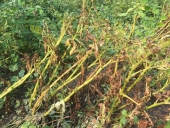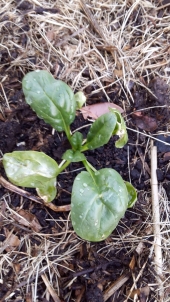
 2
2




Follow some of my adventures in writing here and pick up my cookbook/guide to radio drama Box 13 here
 1
1




August sounds like a terrible time to be travelling through the southwestern states in an old car which obviously would not have air conditioning
Argue for your limitations and they are yours forever.
 1
1




 1
1




My dad told a story of being about that age in Texas during the dust bowl, and one summer they had to go 100 miles with too many people in the car, so four of the kids (him and his twin included) were put in the trunk. It was left open a bit for air, which just added dirt coming in the back to the heat in it. He said it was the most miserable trip he was ever on.August sounds like a terrible time to be travelling through the southwestern states in an old car which obviously would not have air conditioning,
Gardens in my mind never need water
Castles in the air never have a wet basement
Well made buildings are fractal -- equally intelligent design at every level of detail.
Bright sparks remind others that they too can dance
What I am looking for is looking for me too!

 2
2




 1
1




Creating sustainable life, beauty & food (with lots of kids and fun)









 1
1




Follow some of my adventures in writing here and pick up my cookbook/guide to radio drama Box 13 here
 2
2




Gardens in my mind never need water
Castles in the air never have a wet basement
Well made buildings are fractal -- equally intelligent design at every level of detail.
Bright sparks remind others that they too can dance
What I am looking for is looking for me too!

 1
1




Invasive plants are Earth's way of insisting we notice her medicines. Stephen Herrod Buhner
Everyone learns what works by learning what doesn't work. Stephen Herrod Buhner





 2
2




Anne Miller wrote:
One summer, I keep my bedroom door closed the whole summer and complained that air conditioning was too cold.
Follow some of my adventures in writing here and pick up my cookbook/guide to radio drama Box 13 here





 1
1




Pearl Sutton wrote:
Just some local flavor to add to your writing :)
Follow some of my adventures in writing here and pick up my cookbook/guide to radio drama Box 13 here

 4
4




List of Bryant RedHawk's Epic Soil Series Threads We love visitors, that's why we live in a secluded cabin deep in the woods. "Buzzard's Roost (Asnikiye Heca) Farm." Promoting permaculture to save our planet.





 1
1




Follow some of my adventures in writing here and pick up my cookbook/guide to radio drama Box 13 here





 1
1




Follow some of my adventures in writing here and pick up my cookbook/guide to radio drama Box 13 here




Gardens in my mind never need water
Castles in the air never have a wet basement
Well made buildings are fractal -- equally intelligent design at every level of detail.
Bright sparks remind others that they too can dance
What I am looking for is looking for me too!










Pearl Sutton wrote:I read mom some of the directions from that book, and she said it sounded like what you would tell someone who you were giving directions to, and pointed out that if you had never seen a map, and there were no real maps of these areas, you would want someone to tell you how to get there. She envisions the passenger reading it to the driver.
The CH in the directions was the Court House.
Follow some of my adventures in writing here and pick up my cookbook/guide to radio drama Box 13 here
 1
1




Vera Stewart wrote:
Pearl Sutton wrote:I read mom some of the directions from that book, and she said it sounded like what you would tell someone who you were giving directions to, and pointed out that if you had never seen a map, and there were no real maps of these areas, you would want someone to tell you how to get there. She envisions the passenger reading it to the driver.
The CH in the directions was the Court House.
Did you just...know that the court house is there, or did you find an explanation of abbreviations? (I can not find one. I sorta expected one at the front of the book, but...maybe I'm staring right at it?)
And it's not like they'd do a lot of good anyway. Knowing this is highway MM doesn't tell you squat about where you will end up if you go down it, and there weren't maps for things. Try going across Texas sometime with no map and stay on the 2 lane roads. It's a VERY different experience than blowing through on the interstate. And when a road is flooded... well, crap. NOW where do you go? Try looking at a good map of Texas and choose a route, now mentally flood out the road on your route. Now what? How far do you have to backtrack to get to a different route? For weird reasons we did that a few years ago, did Joplin MO to Las Cruces NM all on the back roads. That was interesting and VERY educational. And we DID get flooded out, I think we backtracked 30 miles or so, and we HAD a good map, and signs and a good car, and money for gas...
Apparently part of the problem this guide was addressing was that there weren't too many signs, because most people knew where everything was in their neck of the woods, and not very many strangers were traveling through, so what would you need street/directional signs for? I've never thought about life without street/highway signs in the 20th century before.
Heh, one threat of "shut up or we'll leave you out here" would quell that FAST! :D It's desolate.I also envision the passenger reading the directions, but also the typical arguments from the driver about if they're reading it right, plus I envision the kid reading the book and getting maybe a little bratty about all the interesting sounding things they're missing - I wanna go see the cliff dwellings! No, we're not going to go down some side road, we might break down on the way...and for what, some holes in a rock? But you promised we would see neat things! Sit down and be quiet... (plus maybe it's night-time, because I like the idea of approaching Flagstaff at night time...)
Gardens in my mind never need water
Castles in the air never have a wet basement
Well made buildings are fractal -- equally intelligent design at every level of detail.
Bright sparks remind others that they too can dance
What I am looking for is looking for me too!






 1
1




Pearl Sutton wrote:
I'm magic! :)
Follow some of my adventures in writing here and pick up my cookbook/guide to radio drama Box 13 here

|
The meaning of life is to give life meaning. - Ken Hudgins / tiny ad
The new permaculture playing cards kickstarter is now live!
https://www.kickstarter.com/projects/paulwheaton/garden-cards
|




